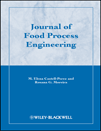EFFICACY OF SODIUM HYPOCHLORITE AND QUATERNARY AMMONIUM COMPOUNDS ON YEASTS ISOLATED FROM APPLE JUICE
Abstract
ABSTRACT
In this work, we evaluated the effectiveness of sodium hypochlorite and a commercial quaternary ammonium compound against four wild yeast strains in their different growth forms: planktonic, sessile and forming microcolonies. These yeasts had been isolated from apple juice processing plant, and appropriate environmental conditions were employed throughout the work. For planktonic cells, 4 log reduction was obtained using the lowest concentration of sodium hypochlorite (200 ppm) on all tested strains. However, quaternary ammonium chloride was effective only on Zygosaccharomyces sp. in all in-use concentrations tested, and only the stronger in-use concentration (1:30) was effective on Rhodotorula mucilaginosa. Because of the above results, the disinfection on sessile yeast cells was performed only with sodium hypochlorite solutions. In cells attached in batch conditions, the highest concentration of sodium hypochlorite (500 ppm) was necessary to get 4 log reduction. In order to obtain a 3 log reduction on Zygosaccharomyces sp. microcolonies formed in laminar flow conditions, the combined action of 0.5% w/v NaOH and 500 ppm sodium hypochlorite was required. We concluded, thus, that cells forming microcolonies under laminar flow conditions were less susceptible to disinfectants than those suspended or attached in batch conditions. These results also indicated that attachment and colonization of autochthonous yeasts must be properly identified to evaluate the effectiveness of disinfectants used in apple juice processing plants.
PRACTICAL APPLICATIONS
Biofilm formation is a serious hygienic problem in food industry. In fruit processing plants, the microbial attachment causes serious engineering problems such as decreases in permeate flow in membrane processes, greatly reducing operating efficiency of ultrafiltration process. Moreover, the presence of microorganisms attached to food contact surfaces could increase the fluid frictional resistance of surfaces, increases the corrosion rate of surfaces leading to energy and production losses and compromises the hygienic quality of the final product causing significant economic losses. Our results show that the evaluation of the effectiveness of a disinfectant on biofilms should be performed using a method where the adhesion and colonization of cells was carried out in flow conditions similar to those of the environment where the disinfectant is applied. We observed that even when using new surfaces, and performing both cleaning and sanitizing under optimal conditions, the risk that the number of viable cells remaining on the surface can generate a new biofilm subsists.




